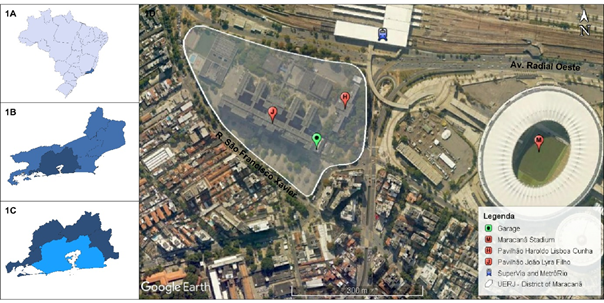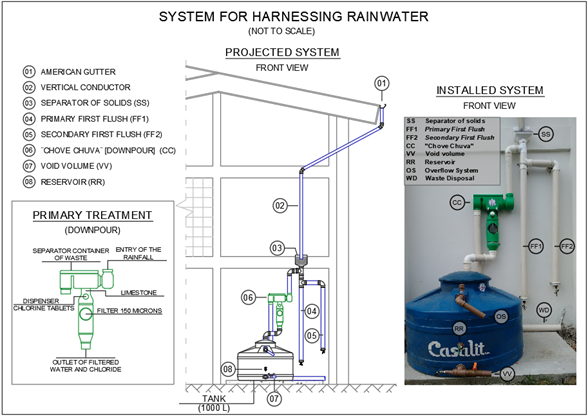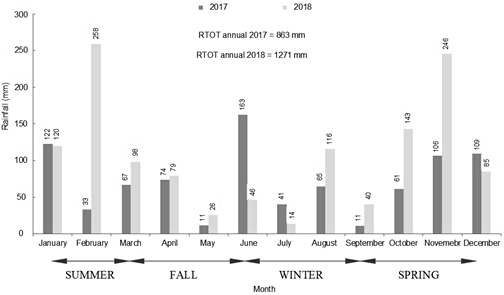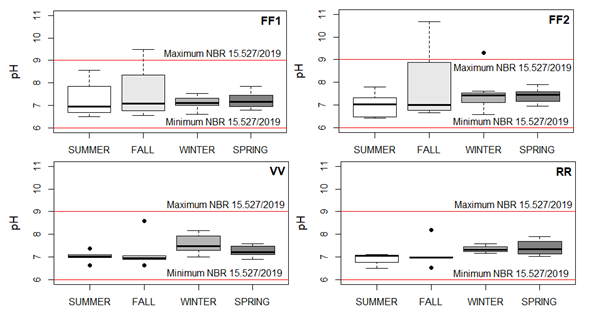International Journal of
eISSN: 2576-4454


Research Article Volume 6 Issue 4
Department of Urban &Regional Planning, Rivers State University, Nigeria
Correspondence: Ibama Brown, Department of Urban &Regional Planning, Rivers State University Port Harcourt, Nigeria, Tel +2348035519084
Received: June 22, 2022 | Published: July 1, 2022
Citation: Oscar AL, Ikezam W, Brown I. Exploring the nexus between urban growth trend and wetland loss in port harcourt municipality. Int J Hydro. 2022;6(4):102-106. DOI: 10.15406/ijh.2022.06.00314
Although Wetlands naturally serve phenomenal roles as natural flood control basins, habitats and breeding grounds for species, ecotourism sites, and biodiversity they have, over time, been depleted to meet man’s increasing demand for land space. This study is a longitudinal survey that looked at the nexus between urban growth and wetland loss in Port Harcourt municipality. Primary and secondary data were used. Primary data were obtained from field observations and ground-trotting. Satellite imageries for four epochs: 1990, 2000, 2010 and 2020 were acquired using Google Earth imageries. Data were analysed using the Geographic Information System (GIS) ArcGis10.4.1 software. The shape file of the study area boundary was generated using ArcGIS 10.4.1 and was used to clip the geo-referenced Google earth images for each year (1990, 2000, 2010, and 2020). The reclassified images were converted to polygons and edited. The area of each classification (land uses) was calculated in square meters using the Spatial Query Module in ArcGIS 10.4.1. Data presentation was done using maps, tables, and charts. Results of analysis revealed that there exists spatio-temporal variation in wetland loss in the study area between the years under review with wetland decreasing form 34633511.38m2 in 1990 to 30945235.9m2 in 2000, and to 23297313.11m2 in 2010 to 18688909.45m2 in year 2020. A very high positive correlation coefficient (Rs) of 0.99 obtained expresses the strong relationship between urban growth and wetland loss in the study area. The study recommends that government and its relevant Ministries, Departments and Agencies (MDAs) should embark on wetland creation, development, and conservation to ensure the continuity in the services, functions, and value of wetland ecosystems in the study area.
Keywords: ecosystem, nexus, port harcourt municipal, wetlands, resources, ecological services
Wetlands are an essential natural resource that enhances the survival of the ecological system. They provide a range of services ranging from a carbon sink, water regulation, biodiversity conservation, and food source. Globally, wetlands occupy less than 9 % of the earth’s terrestrial surface and it is estimated that between 300 million and 400 million people live close to and most times depend on wetlands.1,2
However, the inappropriate use of this essential natural resource has led to its abuse. Wetlands serve as natural waste-water treatment facilities that are crucial for food security. For instance, they support the cultivation of paddy rice which is a staple in the diet of half the world’s population. They also provide flood control measures, clean water facilities, shoreline and storm protection, materials, medicines, and vital habitat for biodiversity. For Davidson3 the global extent of wetlands declined by 64-71% in the 20th century. It constitutes a significant threat to the wetland biodiversity, the livelihood of the indigenous people and those who depend on the wetland ecosystems for their survival.
Nigeria appears to have its fair share of wetland loss. With a land area of 923,768km2 out of which 2.6% are wetlands, the percentage of wetland loss in Nigeria stands at 6.5% per annum due mainly to rapid urbanisation.4 Rapid urbanisation accentuates the demand for land space for physical development for housing, road construction, industries, factory development, and waste dump sites. According to Sule5 urbanisation has engendered incessant conversion of wetland ecosystems in Nigerian urban centres to different uses resulting in the total disappearance and loss of wetland ecosystems, their values, functions, and services.
Port Harcourt City is one of the Local Government Areas in Rivers State. It houses the state capital and is home to most oil and gas industries in Nigeria which has continued to exercise centripetal influence, pulling people and firms into the city. According to the National Population Commission (NPC, 2006),4 the population of Port Harcourt City Local Government Area alone (within its municipal boundary) grew from 7,000 residents in 1921 to 703,420 persons in 1991, indicating an increase of 696,420 persons in 70 years. The projected population in 2021, with a 6.5% annual growth rate, is 4,368,710 persons.
Rapid urban growth with its attendant physical changes in the cityscape leads to high demand for land space for various physical developments. Since land as a resource is fixed, increasing land stock to accommodate city growth often results in encroachment into wetland ecosystems through wetland reclamation. Incidentally, the increasing rates of wetlands conversions through reclamations in Port Harcourt have resulted in massive destructions and consequent disappearance of available wetlands. There is a need to quantitatively establish the actual wetland loss in the study area. The present study therefore, examines the trend extent of wetland loss in Port Harcourt municipality between 1990-2020.
Port Harcourt lies approximately on latitude 40 17’ 98”–40 47’ 21” E and longitude 60 09’ 99’– 60 59’ 55” N of the Greenwich Meridian6 (Figure 1). Port Harcourt houses three oil refining companies and two seaports with an international Airport, all of which account for its rapid urbanisation heading towards the Northern fringes of Port Harcourt.7

Figure 1 Port Harcourt Municipality administrative map
Source: Urban and Regional Planning Department, Rivers State University, Port Harcourt (2020)

Figure 2 Spatio-temporal Analysis of Land Use/Land Cover Change in Port Harcourt Municipality in 1990.
Source: Authors’ Analysis, 2022
Port Harcourt City Local Government Area features a tropical monsoon climate with a long heavy rainy season and an abridged dry season.6 Only December and January genuinely qualify as the months of the dry season in the city.8 Harmattan, which climatologically influences many metropolitan and urban areas in West Africa, is less pronounced in the city.9 The city’s heaviest precipitation occurs during September, with an average of 370mm of rain. In terms of the general surface features, Port Harcourt city falls within its urban boundary within the coastal area dominated by low-lying coastal plains that structurally belong to the sedimentary formations of the recent Niger Delta.10
The soil consists of superficial deposits over 100m thick in places. The soil is also poorly drained but has rich humus layers at the topsoil, with a deficiency in Nitrogen and Potassium due to intense leaching of the soil caused by heavy rainfall. The geology and the type of soil within the wetlands areas in the study area make it very productive and highly suitable for aquatic and other marine organisms to survive.11
The seaports and the railway, including the trunks roads that connect various states in the country’s south-south and southeast regions, have attracted investors and helped boost economic activities and the state’s economic fortune with the state attendant pressure on land resources in the area.
This study hinges on the positivist research worldview employing the quantitative research approach. The research design is longitudinal survey research because it looks at wetland loss over time. Both primary and secondary sources of data were used for the study. The primary data took the form of direct field observations and ground-truthing. To holistically examine the extent of wetland loss using satellite imageries of Port Harcourt for three epochs from 1990, 2000, 2010 and 2020 were acquired from Google Earth. The imageries have a resolution of 1116m and were captured from 10km above ground level. Data analysis was achieved using Geographic Information System (GIS) software ArcGis10.4.1. The shape file of the study area boundary was generated using ArcGis 10.4.1 and was used to clip the geo-referenced Google earth images for each year (1990, 2000, 2010, and 2020). Maximum likelihood supervised classifications were carried out in ArcGIS 10.4.1 on the clipped Google earth images. Three classes were identified, namely built-up areas, water bodies and wetlands. The classified land-use images were further reclassified using ArcGis 10.4.1. The reclassified images were converted to polygons and edited. The area of each classification (land uses) was calculated in square meters using the Spatial Query Module in ArcGIS 10.4.1. Simple arithmetic was carried out on the polygons to ascertain percentages of wetlands loss in each year (1990, 2000, 2010 and 2020). Data presentation was done using maps, tables and charts.
Literature
Obia et al.12 studied urban development in the Third World and the threat to wetlands, using Calabar, Nigeria, as a case study. The study examined the danger posed by the spread of city to wetland areas within the urban fringes in Calabar. Although the study was a desktop study that employed existing literature for its analysis, the paper specifically examines the threat posed by population growth and the attendant urban development on the existing Calabar City wetlands against the backdrop of the potential of the architectural development these wetlands for ecotourism resorts. The study revealed that a lack of understanding of the wetland ecosystem results in bad professional judgments that pose diverse dangers to the occupants of the building and other forms of developments sited in wetland areas. As part of its recommendations, the study suggests the outright prohibition of all forms of physical developments in these ecologically sensitive wetland ecosystems of the city because urban development falls constitutionally within the purview of the state government. Therefore, it is a matter of urgency for the government of Cross River State of Nigeria to establish; the necessary framework for the prohibition of physical developments on wetlands within the city and the conservation of the city’s rapidly shrinking wetland ecosystems.
Also, Basnyat, Khanal and Gauli13 conducted a study on the total economic valuation of wetland ecosystem services. The study was carried out at the Zagadishpur reservoir catchment area of Nepal. The Reservoir was a Ramsar site in 2003 in recognition that it supports vulnerable and critically endangered species and other threatened ecological communities. The study adopted market and non-market-based valuation techniques to estimate the total economic value of the Reservoir. In addition, household surveys, focus group discussions, and interaction with the tourism entrepreneurs and district stakeholders gathered information. The study noted that wetlands have the most productive ecosystem and provide vast arrays of wetland ecosystem (goods and services) to the local communities in particular and global communities.
Furthermore, the study reveals that the wetland ecosystem provides a range of goods and services that help life support systems conserve biodiversity, and act as a safety net, environmental insurance against climate change and ecosystem degradation. The study thus recommended that local government and other stakeholders be sensitised to invest in wetland restoration.
Similarly, Weje and Dapa14 conducted a study on the impact of development projects on reclaimed wetlands in Port Harcourt. The study used the cross-sectional research design and adopted the survey research approach. Reclaimed wetland area from 1990 to 2017 was examined, and the grid method of supplying the population for the study was adopted. The data collected were analysed using descriptive statistics, and the time series analysis was used to examine the trend in wetland conversion from 1990 to 2017. GIS technologies were used to show the extent of wetland loss. The study revealed that development projects such as housing and infrastructure/facilities provision on the reclaimed wetlands have negatively impacted the affected environment. The extent of wetlands loss has caused a significant change in the ecological and ecosystem functioning of the urban environment of the affected area.
Besides, Brown and Dapa15 studied the consequences of wetland conversions and reclamation in Port Harcourt municipality using the ERDAS Imagine 2014 version. The study ascertained the extent of wetland loss based on urbanisation which is the highest usurper of the wetland. The study found that rapid urbanisation was the primary cause of wetland loss in the Port Municipality and concluded that there is a price to pay for every wetland reclamation and subsequent loss. The price paid by residents around the wetlands is in the form of constant flooding in the neighbourhood since there is a distortion of the natural water basin and flood control services of the wetlands.
Spatio-temporal analysis of Wetland loss in Port Harcourt between the Years 1990, 2000, 2010and 2020
Table 1 shows the land use budget of the study area for 1990, 2000, 2010 and 2020. The result revealed that in 1990, wetlands covered an area of 346,33511.38m2 (32.2%), built-up occupied an area of 25,123,366.48m2 representing 26.4%, vegetation 32,607,445.37m2 (24.1%), while water body 19476035.29m2 (17.3%) (See fig.2). In 2000 however, the land space devoted to built-up areas increased to 33,453,258.9m2 representing 31.8% as against of 25,123,366.48m2 (26.4%) in 1900. Implicitly, an estimated additional land amounting to 8,329,892.42m2 was added to the built-up with a percentage change of 33.2%. The amount of land devoted for vegetations in 2000 depreciated from 32,607,445.37m2 (24.1%) in 1900, to 28,960,713.22m2 (22.5%) in 2000 with a percentage change of -11.2% (Figure 3). Similarly, waterbodies in the study area also reduced from 19, 476, 035.29m2 (17.3%) to 1799003.62m2 (16.5%) with a percentage change of -90.8 the same for wetlands that had a sharp drop losing 3,688,275.48m2 from 34633511.38m2 in 1900 to 30945235.9m2 in the year 2000. This implies that about 3,688,275.48m2 of wetland ecosystems were converted and reclaimed to accommodate urban growth between 1990 -2000 in the study area.
Land use |
Area covered in square meters |
Percentage coverage |
||||||
1990 |
2000 |
2010 |
2020 |
1990 |
2000 |
2010 |
2021 |
|
Built up areas |
25,123,366.48 |
33,453,258.90 |
61582759 |
64172356 |
26.4 |
31.8 |
58.2 |
62.3 |
Vegetations |
32,607,445.37 |
28,960,713.22 |
2.72E+08 |
23610313 |
24.1 |
22.5 |
5.1 |
3.7 |
Water body |
19476035.29 |
1799003.62 |
17589238 |
16866455 |
17.3 |
16.5 |
15.2 |
14.4 |
Wetlands |
34633511.38 |
30945235.9 |
23297313 |
18688909 |
32.2 |
29.2 |
21.5 |
19.6 |
Table 1 Land use pattern in Port Harcourt between the Years 1990, 2000, 2010 and 2021
Source: Authors’ Field Survey, 2022

Figure 3 Land Use/Land Cover Change in Port Harcourt Municipality in the year 2000.
Source: Authors’ Analysis, 2022
The scenario for 2010 and 2020 also showed intriguing revelations as wetlands further decreased dropping from 30,945,235.9m2 in the year 2000 to 23297313.11m2 in 2010 with a percentage change of -10.7 (Figure 4 & 5) even though there was further drop in wetland to 18688909.45m2 in year 2020 with a percentage of -19.8 between 2010-2020 (Table 2).

Figure 4 Land Use/Land Cover Change of Port Harcourt Municipality in 2010.
Source: Researcher’s Analysis, 2022

Figure 5 Land Use/Land Cover Change of Port Harcourt Municipality in 2021.
Source: Authors’ Analysis, 2021
Land use |
Change in area covered in square meters |
Change in percentage |
||
1990–2000 |
2010–2020 |
1990–2000 |
2010–2021 |
|
Built up areas |
8,329,892.42 |
2589597.58 |
33.2 |
4.2 |
Vegetations |
-3,646,732.15 |
-248,287,390.26 |
-11.2 |
-91.3 |
Water body |
-17,677,031.67 |
-722,783.33 |
-90.8 |
-4.1 |
Wetlands |
-3,688,275.48 |
-4,608,403.66 |
-10.7 |
-19.8 |
Table 2 Percentage Change in Area Coverage port Harcourt between the Years 1990-2021
Source: Authors’ Field Survey, 2022
The scenario for 2010 and 2020 showed more intriguing revelations as there appears to be further decline in wetland in the area dropping from 30,945,235.9m2 in the year 2000 to 23297313.11m2 in 2010 with a percentage change of -10.7.For 2020, wetland loss further dropped to 18688909.45m2 with a percentage of -19.8 as against 23297313.11m2 in 2010 (Table 2).
To examine the level of correlation between urban growth and wetland loss, the null hypothesis stated is of this form:
A Pearson product moment correlation coefficient (Rs) of 0.99 was obtained indicating a very strong positive relationship between urban growth and wetland loss (Table 3). The result also showed that 98% variation in wetland loss is explained by urban growth. Since a t-calculated value of 1.606 was obtained and is greater than 0.05 significant levels, we reject the null hypothesis and uphold the alternate hypothesis. Thus we conclude that there is significance relationship between urban growth and wetland loss in Port Harcourt municipality.16,17
Model |
R |
R Square |
Adjusted R Square |
Std. Error of the Estimate |
1 |
.992a |
.984 |
.951 |
1600954.94595 |
Table 3 Model Summary
Source: Researcher’s Field Survey, 2022
Over the years, the study of wetlands has engendered writings from different scholars because wetlands play essential role in the overall sustenance of the ecosystem. This study examined the nexus between urban growth and wetland loss in Port Harcourt municipality for the years 1990, 2000, 2010 and 2020. From the analysis it was observed that there is spatio-temporal variation in wetland loss in the study area between the years under review with wetland decreasing form 34633511.38 M2 in 1990 to 30945235.9M2 in 2000, and to 23297313.11M2 in 2010 to 18688909.45M2 in year 2020.
A very high positive correlation coefficient of 0.99 obtained expresses the relationship between urban growth and wetland loss in the study area. The study therefore recommends that the following:
The government and its relevant MDAs should embark on wetland creation, development and conservation to ensure the continuity in the services, function and value of wetland ecosystems in the study area.
None.
The author declares there is no conflict of interest.

©2022 Oscar, et al. This is an open access article distributed under the terms of the, which permits unrestricted use, distribution, and build upon your work non-commercially.